There is no doubt that diesels are an integral part of railway preservation but this was not always the case. Brian Sharpe delves into the increasingly complex world of British main line diesel preservation.
On May 24, 1973, WR Warship B-B diesel-hydraulic D821 Greyhound became the first BR main line diesel locomotive to be purchased privately for preservation.
Enjoy more Heritage Railway reading in the four-weekly magazine.
Click here to subscribe & save.
The group that bought it had actually asked BR for North British Class 22 D6319, but it was scrapped by mistake and BR offered one of the last four surviving Warships instead.
When BR published its Modernisation Plan in 1955, the replacement of steam by diesel traction was only one part of the overall plan. Dieselisation was carried out very hastily with far too many engines of totally unproven designs being ordered.
Many of the early diesel classes never did work reliably and did not last long, but where the plan fell down in respect of motive power was that diesels were designed to simply replace steam engines of the same size and power on the duties they were currently performing. There was little attempt to predict how railway operations would develop.
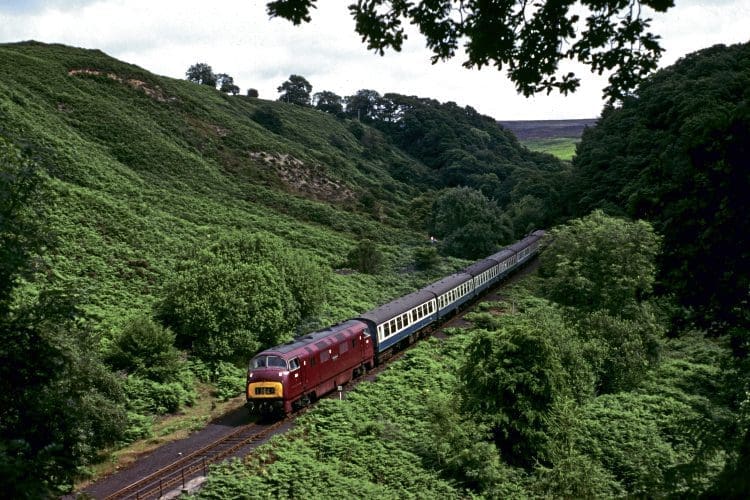
So the first diesels to be ordered in quantity were Type 1 1000hp Bo-Bos that were expected to replace 2MT 2-6-0s on branch pick-up goods trains. With a cab only at one end, they even looked a bit like steam engines and did not have train heating boilers so they were of no use on passenger trains in winter.
Pick-up goods trains had virtually disappeared within 10 years, as had most of the branch lines and BR was left with 227 of the English Electric Type 1s, the only ones that had proved anything like reliable, while similar engines from other manufacturers had been scrapped fairly quickly.
The Type 1s found themselves permanently coupled nose-to-nose hauling loose-coupled coal trains, particularly in the Midlands. This was not what they were designed for and it must have been an expensive way of operating such trains when a single higher-powered engine would have sufficed.

Meanwhile, steam was in rapid retreat and enthusiasts had little affection for the machines that were replacing steam engines. But times were to change…
Shunting and works trains
Diesel preservation was nothing new and had started in the early days of narrow gauge preservation with various ancient petrol and diesel-powered units for shunting and works trains followed by most standard gauge heritage lines making use of industrial shunters and the later acquisition of more powerful BR shunters for such jobs. GWR railcars and BR railbuses and DMU sets were also being purchased for heritage line use. Main line diesel locomotives were a different matter.
Greyhound was worthy of preservation for its own historical merit and there was always the intention that it was for active service.
The attitude to diesel preservation had never been quite the same as it was for steam. It is now universally agreed that the most significant diesel locomotive historically was the LMS No. 10000, the first successful main line diesel in Britain, but this was not included in the list of historical relics published by the British Transport Commission in 1960. Despite lasting in service until 1966, it was scrapped.
Its sister No. 10001 lasted a little longer and spent a considerable time in store, during which time there was an attempt at private preservation but this was met with little enthusiasm and was unsuccessful.
The prototype Deltic had been presented by its builders, English-Electric, to the Science Museum, becoming the first of several diesel locomotives in the National Collection.
BR’s first-generation diesel classes were a mixed bunch and some were quite quickly rendered extinct with no thought that an example ought to be preserved.
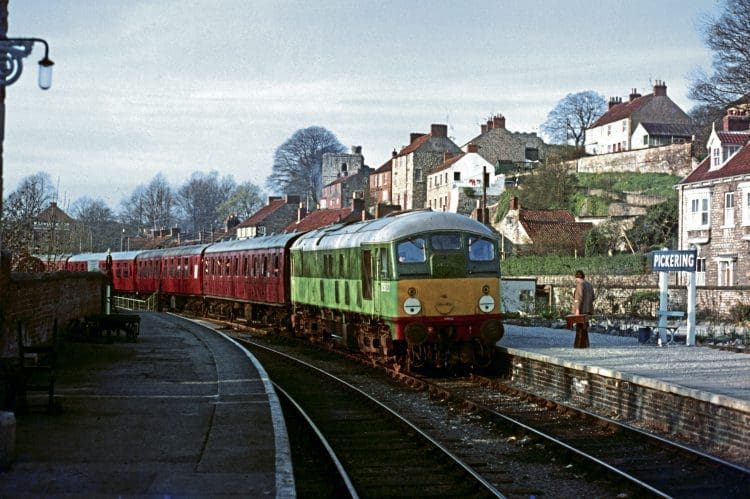
BRIAN SHARPE
The WR diesel-hydraulic classes were generally considered to be successful and they were withdrawn relatively early, simply because they were non-standard.
The hydraulics were different and, rather like steam traction, they effectively belonged to a bygone era.
The longest-surviving hydraulics were, of course, the Class 52 Westerns and by the time the last ones were withdrawn in early 1977 after only 15 years’ service, they had acquired a following among enthusiasts way beyond that ever accorded to any express steam class, A4s, Duchesses, Kings and Bulleid Pacifics included.
No less than seven Westerns were preserved; D1023 Western Fusilier being claimed by the NRM for the National Collection.
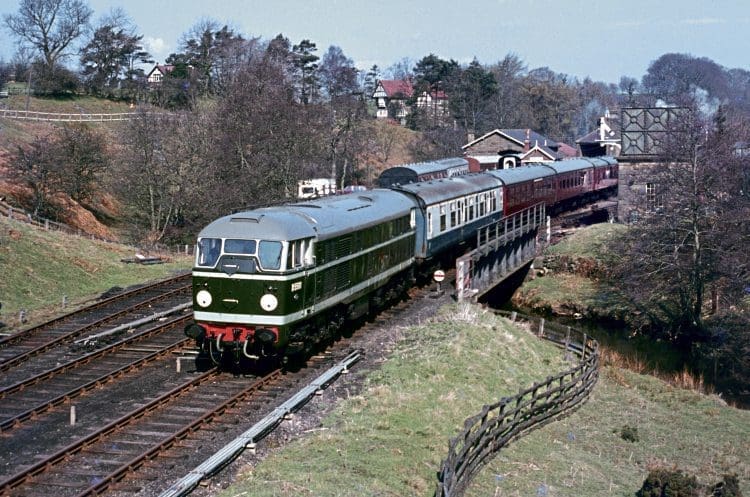
While Warship D821 saw little active use at first, the Westerns were a different matter. In July 1977, D1062 Western Courier became the first preserved diesel to haul a main line railtour, although only over the metals of the then Torbay Steam Railway.
Regular passenger use
A generally successful class of smaller diesel was the BR/Sulzer Type 2 Bo-Bo, the first batches of which became TOPS Class 24.
These were withdrawn more quickly than the later Class 25s and it was a Class 24 that became the first main line diesel to see regular passenger use on a heritage line. D5032, by now numbered No. 24032, was withdrawn in July 1976 and sold to T J Thomson Ltd, a Stockton scrap dealer, but the North Yorkshire Moors Railway was able to secure the long term loan of this locomotive and it quickly proved its worth on a variety of duties on what was then one of Britain’s lengthiest and busiest heritage lines.

The long, hot summer of 1976 had caused a number of lineside fires, resulting in a ban on steam operations, and leading to a Class 08 shunter and then a Class 101 DMU being hired from BR. D5032 proved much more suitable and effectively saved the railway that year.
This set a precedent that virtually all heritage lines have followed, with the notable exception of the Bluebell Railway, which until quite recently adopted a strict ‘no diesels’ policy.
Diesels were purchased by the railways themselves; by private individuals; or by preservation groups or societies. Some of the groups, such as the Western Locomotive Association, Deltic Preservation Society or the Diesel Traction Group, have developed into large organisations, while individuals such as Michael Timms and Michael Owen became major players in the industry.
Legendary Deltics
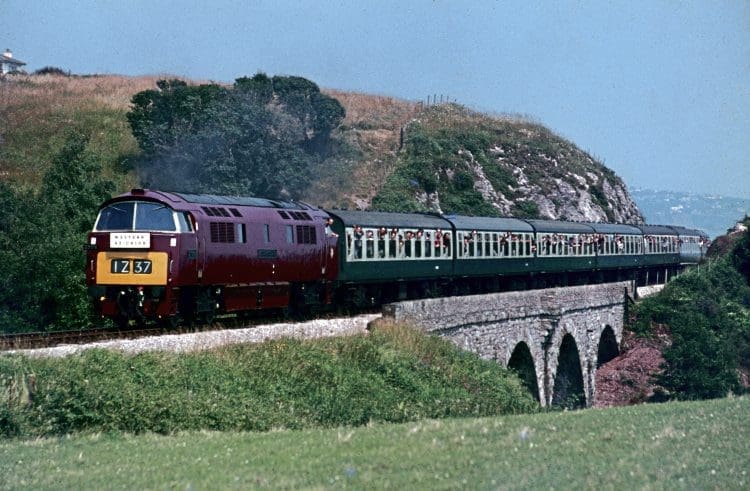
The NRM claimed the first of the Brush Type 2s, now known as a Class 31/0, No. 31018 for the National Collection and this was quickly returned to its original condition as D5500 and also worked trains on the NYMR in the late 1970s.
The withdrawal of the last of the 22 legendary Deltics at the beginning of 1982 was met with virtually the same level of enthusiasm among enthusiasts as had marked the Westerns’ demise five years earlier.
Six of the 3,300hp 100mph engines entered preservation, again with one in the National Collection. It was still difficult to imagine one working heritage line passenger trains but it was either that or nothing.
BR would not entertain the use of preserved diesels on its metals. The Deltics did adapt to their new very different circumstances and retained their devoted following.
By the early 1980s, diesel classes were disappearing quite quickly and with whole classes being rendered extinct, BR had no need to retain withdrawn engines as sources of spares and they had relatively little scrap value.

Not only did most heritage lines start to acquire main line diesels, but private individuals and preservation societies were able to purchase redundant diesels, often in
good condition.
This has ultimately led to unheard of numbers of diesels entering preservation by comparison with steam. There are 28 preserved Class 20s, 20 Class 25s, 36 Brush Type 2s were preserved and 45 Class 37s so far.
No less than 21 of the BRCW/Sulzer Type 2s associated with Scotland are preserved; almost a quarter of the class but even this proportion is exceeded by the larger BRCW/ Sulzer Type 3 Class 33s from the Southern Region, where 25 of the 98 original engines are preserved.
Highest proportion
Even the larger type 4 diesels have done well, with seven Class 40s, 16 of the three classes of Peaks and 36 of the once-numerous Class 47s, but the record for the highest proportion of the original class in preservation is held by the Class 50s, with 17 of the original 50 locomotives having been preserved.
One of the least useful classes of BR diesel in regular service has turned out to be one of the most useful in preservation.
The WR built 56 diesel-hydraulic 0-6-0s in 1964, basically for branch line and trip freight workings, just the sort of traffic that very quickly disappeared. They were withdrawn within a few years but a large number were sold on for industrial service; again though for traffic that was to quickly disappear.

The Class 14s were not shunting engines and were capable of 40mph running. They were ideal for just about any duties asked of them on heritage lines and many were purchased from the National Coal Board and the British Steel Corporation; the 19 survivors now being spread right across the country.
Also preserved after industrial service was the last Class 17 Clayton Bo-Bo D8568, the last survivor of one of BR’s least successful classes.
A handful of diesels found use after withdrawal under the auspices of the Research Centre at Derby and survived long enough to enter preservation, ensuring that we still have a Metro-Vick Co-Bo; D5705, although its restoration is a very long-term project.
Others found use as mobile generators for carriage heating; an example being the sole-surviving Class 15 type 1 Bo-Bo D8233, which survived to be preserved. Both these engines are proving to be very long-term restoration projects but good progress is being made.
Although there was never a diesel equivalent of Woodham’s scrapyard at Barry, the roles played by a couple of private scrapyards in the story of diesel preservation are significant. Vic Berry’s yard at Leicester was famous for its pile of Class 25 bodyshells and Berry’s was involved not only in scrapping locomotives but also in the complex task of asbestos removal.
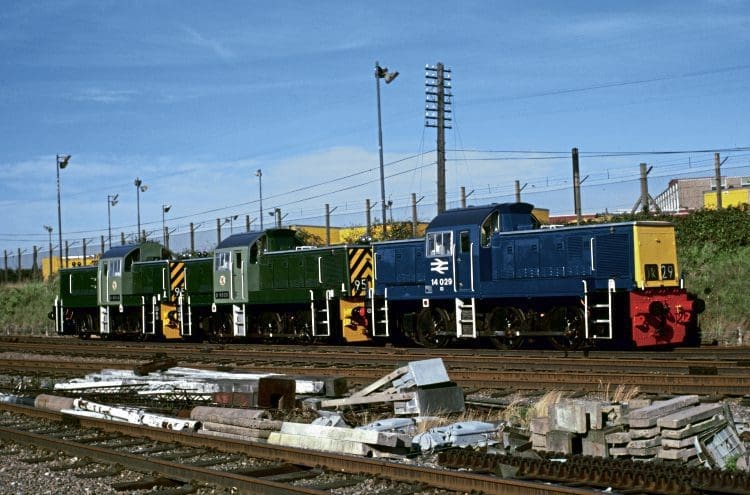
While some engines were purchased from the yard for preservation, others already saved made the journey to the yard purely for the purpose of having all traces of the toxic substance removed under controlled conditions before being able to join the ranks of preserved locomotives.
Similarly, Booth’s at Rotherham was noted for disposing of many of the Class 50 fleet and several were purchased instead of being scrapped, particularly under ‘Operation Collingwood’, and some eventually found salvation, although most proved eventually to be beyond redemption.
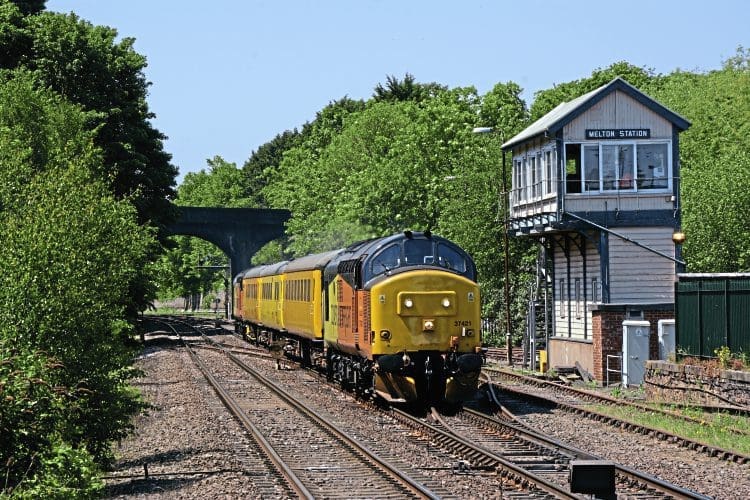
BR’s sectorisation saw the still large but quite elderly diesel fleet split up into the various passenger and freight sectors and given new liveries. This was followed by Privatisation, when new Train Operating Companies inherited this ageing fleet, including some quite low-powered types with little investment in new locomotives having taken place for many years.
The end
When EWS, a subsidiary of US company Wisconsin Central, took over virtually all freight operations, it quickly invested in a fleet of 250 North American-built Class 66 type 5 Co-Cos that would be far more suited to modern-day railway operations and spelt the end of the first-generation diesel survivors.
Now clearly on borrowed time, many individual engines became ‘celebrities’ and were returned to original liveries and numbers or given colourful one-off liveries and in many cases, after being much in demand for railtour duties, their eventual preservation was in many, though not all cases, assured.
Well over 300 main line diesels can be considered as preserved but this total is constantly changing. The relative cheapness of these engines and the substantial numbers purchased has led to ‘preservation’ sometimes being short term in nature.
For example no less than 10 of the 36 ‘preserved’ Class 31s have now been scrapped and many ‘preserved’ diesels are dumped in atrocious condition. At the other end of the scale, many ‘preserved’ diesels have returned to main line service.
The main line use of preserved diesels has been a story in itself. BR banned the use of privately-owned steam locomotives on its tracks in 1967 but just four years later this ban was lifted. At the time the question of the operation of privately-owned diesels simply did not arise. Once D821 was purchased in 1973 though, thoughts were starting to turn in this direction. It was quite hard then to see what use a type 4 or 5 diesel could ever be on a heritage line.
It was Pete Waterman who was determined to get one of his engines into main line service. BR lost the argument by allowing such privately-owned engines as Foster Yeoman and National Power’s Class 59s and the Hunslet-Barclay weedkilling Class 20s to operate on its tracks, so why not a Waterman Railways’ Class 46?
Although it capitulated, the stringent criteria imposed by BR on D172 Ixion made it possibly the most expensive preserved diesel in Britain.
Ixion made its main line passenger debut on October 1 and 2, 1995. It ran a few times in railtour service but did not have the pulling power among enthusiasts of a Western or a Deltic; the preserved examples of which still seemed no nearer to returning to main line action. Diesel locomotive owners were waiting to see how Waterman got on with his Peak before going down the expensive road of main line certification.
Railtour service
Privatisation totally moved the goalposts. From 1994, anyone who owned a diesel could run it on the main line subject to normal reliability and safety criteria. Not only were quite large numbers of main line diesels acquired from BR by newly-formed Train Operating Companies, but a variety of preserved diesels started to see railtour service.

Some even ran in regular passenger or freight service, a situation that continues to this day. Diesels that were once considered preserved have even been resold to passenger or freight Train Operating Companies and classes regarded as obsolete by BR years ago are back in front line service.
Of the Type 4 and 5 first generation diesel classes, one Western and five Deltics have since seen main line use as preserved engines, plus two Peaks and a Class 40, but their main line appearances are becoming rather more infrequent. In the case of Classes 47 and 50, it is becoming difficult to distinguish between ‘preserved’ and otherwise as far as main line use is concerned.
TOCs such as West Coast Railways have operated Class 33s, 37s and 47s for many years now and although West Coast is seen as an operator of main line trains mainly in the heritage sector, its diesels should not be regarded as preserved and, if they are no longer required they will simply be sold or scrapped.
A remarkable number of ‘preserved’ Class 37s, often totally unrestored, have been purchased recently by both Colas and DRS for main line service, although not all have been overhauled after purchase. Other restored class members have been hired by their private owners to such operators for regular main line use.
Preserved diesel liveries are an interesting subject. Prior to 1967, with a few notable exceptions, diesels were generally turned out in BR green. Corporate rail blue was then adopted, with the Class 50s appearing in this livery from new.
So enthusiasts who remember steam remember BR green diesels, whereas those whose memories only stretch back to blue diesels have little interest in steam. As a result a high proportion of owners of preserved diesels tend to prefer them to carry corporate blue. Even the NRM has a tendency to display its diesels in BR blue livery to represent a particular era in the history of train travel.
Nevertheless there is a representative selection of the many and varied liveries carried by diesel locomotives during their long careers, to be seen on the heritage lines in 2017 and diesel galas can certainly be colourful events.
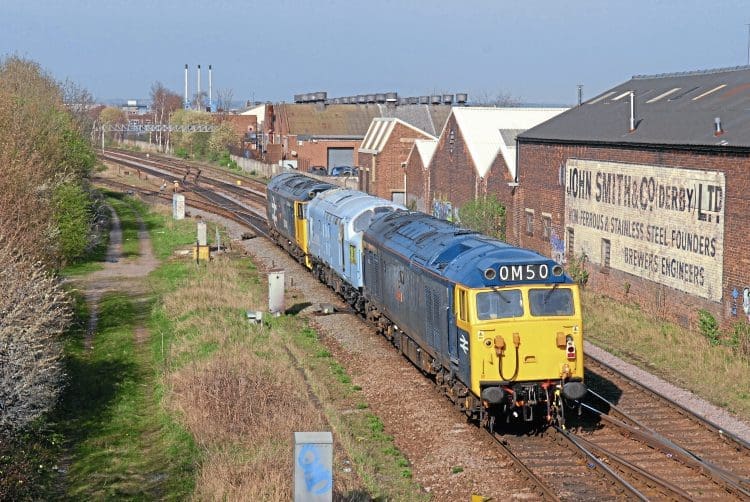
There are parallels with steam preservation in that new-build projects are underway to recreate lost classes, using suitable parts from donor locomotives. We may yet see not only a ‘Baby Deltic’ but even LMS/English Electric Co-Co No. 10000.
Well-known prototypes
The prototype Deltic was preserved in the Science Museum becoming part of the National Collection and is now on display at Locomotion in Shildon but the other well-known prototypes such as Lion, Falcon, DP2 and GT3 were all scrapped, while Kestrel disappeared to Russia.
A notable exception was one of the gas-turbine prototypes ordered by the GWR; No. 18000, which was eventually preserved in Switzerland and many years later returned to these shores.
The only significant new classes introduced by BR after the Class 50s in 1967 were the type 5 Co-Co Class 56 and Class 58 heavy freight locomotives in the 1970s and eventually the Class 60s in the 1990s.
The new Class 66s replaced many of these, as well as much lower powered types, such as the last few Class 31 type 2s. While many of the three type 5 freight classes found new employment; some even on the Continent, or with new smaller TOCs, a few have entered preservation.
The prototype High Speed Train power car should not be overlooked. Having been claimed by the NRM, No. 41001 was loaned out and returned to service by Project Miller at the Great Central Railway (North) at Ruddington.
It is a popular choice for the open day and diesel gala circuit, complete with three matching Mk.3 coaches.
The Southern Region had a small fleet of electrics that were converted to electro-diesels and these were augmented by the new lower powered Class 73 Bo-Bos, which had a 1600hp diesel engine enabling limited use off the SR electrified network.
While the Class 73s lost their passenger duties such as the ‘Gatwick Express’, they have never become totally redundant on the main line network. Their simple construction and low power makes them useful on heritage lines but new main line uses continue to be found, including being fitted with larger engines for such duties as the ScotRail sleeper services.
Many engines considered preserved have found their way back into main line use and the distinction between preserved and main line Class 73s is becoming increasingly blurred.
Electric locomotives have not been overlooked by preservationists, although few have seen active use. London Underground keeps its Metropolitan-Cammell Bo-Bo No. 5 Sarah Siddons going and a couple of preserved WCML Class 86s and an 87 are certified for main line use.
Others, such as the NER Bo-Bo No. 1 and three LNER Woodhead route engines, are on static display but many examples of other WCML types are under restoration, many at Barrow Hill.
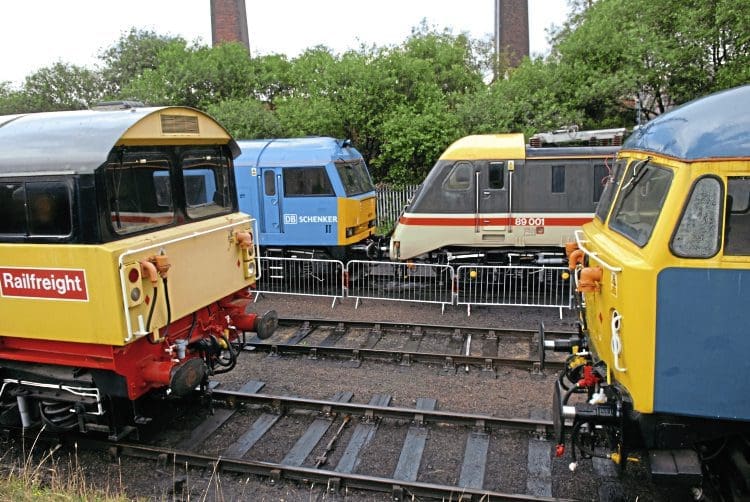
Also on static display are parts of the experimental Advanced Passenger Train APT-E at the NRM and one of the production units at the Crewe Heritage Centre.
Preserved diesels are never going to attract the general public to travel on heritage lines in the same way that steam engines do. Even new-generation lines, which have been predominantly diesel-worked for years, have found that a visiting steam engine will boost their passenger figures significantly.
Nevertheless, diesels, even very big ones, are useful in many ways, as standby engines or during periods of high fire risk and they do have a large and enthusiastic following, particularly among the generation that does not remember steam.
Read more News and Features in Heritage Railway – on sale now!
Archive enquiries to: Jane Skayman on 01507 529423 – [email protected]
Advert
 Enjoy more Heritage Railway reading in the four-weekly magazine. Click here to subscribe.
Enjoy more Heritage Railway reading in the four-weekly magazine. Click here to subscribe.




